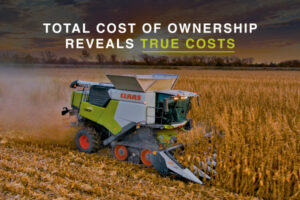Farming as a family affair: Building strong relationships with your dealers Farming is more than…
Breaking Down Total Cost of Ownership

Travelling down the I-65 in Indiana, I see many of you are deep into harvest. As you wrap up these long days (if weather allows), slowing or stopping for a quick in-cab lunch, you may be thinking about the important machinery decisions on your farm: whether to upgrade or replace your combine.
You have the quotes waiting for you on your desk, but you’re still wondering which direction to take to ensure you get the machine that’s best for your business. For YOUR farm.
Understanding the total cost of ownership (TCO) of a combine is essential for making smart purchasing decisions. It’s more than just the sticker price; it’s the whole financial picture of owning and operating the machine the entire time you own it.
The TCO formula: A simple breakdown
To simplify TCO, we can use this formula:
- Net Harvesting Cost = Loan Payment + Running Costs – Running Savings
Let’s break down each component using a real-world example comparing two class-7 machines:

Pictured above: John Deere S770 with John Deere C12R corn head (left) and CLAAS TRION 740 with CLAAS 12-30c corn head
This is what you’ll pay in loan payments annually on your financing plan:
- John Deere S770
- $75,000 per year for 5 years
- CLAAS Trion 740
- $79,000 per year for 5 years
At first glance, the John Deere seems less expensive with $20,000 less in total payments. But then, add in operational variables, namely those relating to harvesting speed and fuel consumption. For both machines, harvesting 2,000 acres of corn each year will require:
- John Deere S770
- Fuel consumption: 0.93 gallons/acre
- Total running costs: $25,487
- CLAAS Trion 740
- Fuel consumption: 0.59 gallons/acre
- Total running costs: $20,413
This adds up to an annual savings with the CLAAS machine of $5,074, or $25,370 over five years. And don’t overlook grain loss and unloading rates! These can significantly impact your bottom line:
- John Deere S770
- Grain loss: $35,040
- Unloading time: 39 hours
- CLAAS Trion 740
- Grain loss: $18,840
- Unloading time: 34 hours
The CLAAS saves $16,200 on grain loss alone and finishes harvest 5 hours earlier each year!
The verdict: TCO reveals the true costs
By applying the formula to our example, we find over five years:
- John Deere S770
- Loan payments: $375,000
- Running costs: $127,435
- Running savings: $81,000
- Net harvesting cost: $521,435
- CLAAS Trion 740
- Loan payments: $395,000
- Running costs: $102,065
- Running savings: $101,000 Net harvesting cost: $496,065
Despite higher loan payments, the CLAAS Trion 740 is actually $25,370 less expensive to own and operate over five years thanks to lower running costs and grain loss during harvest. Plus, with the time savings each fall, you get extra time to enjoy Florida!

Take the next step and make informed decisions with TCO
By calculating and comparing TCO for different combines, you can choose the one that truly aligns with your budget and operational needs. So, don’t just focus on the initial price: Think long-term and factor in all the costs involved.
Ask your CLAAS FARMPOINT dealer for detailed TCO calculations for the combines you’re considering. Use online TCO calculators to estimate costs based on your specific farm conditions. Consider fuel efficiency, grain loss and unloading speed alongside purchase price. Remember, a well-informed decision today can lead to significant savings and a more profitable harvest tomorrow!
